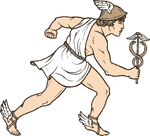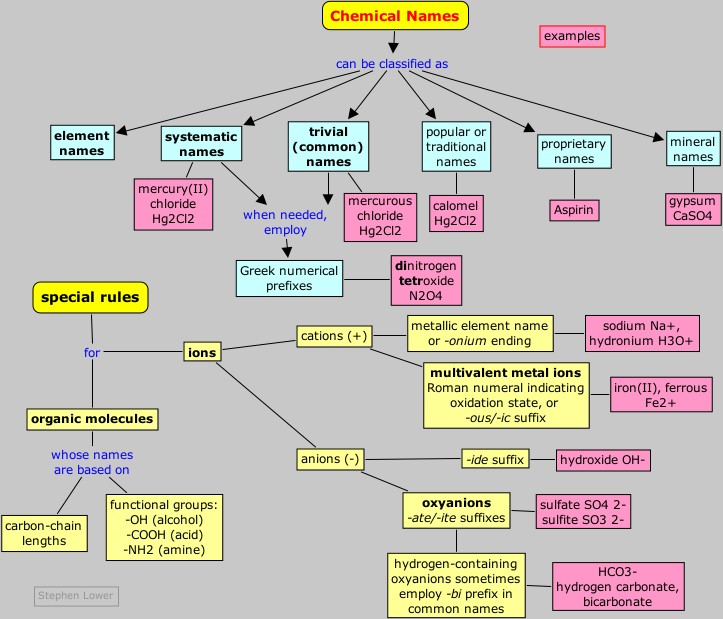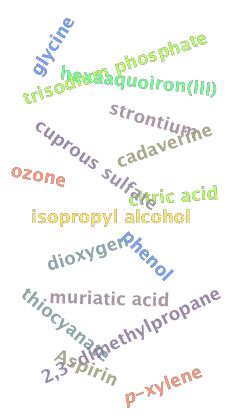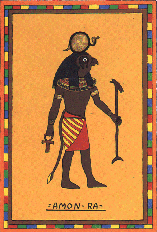Naming chemical substances
Introduction to chemical nomenclature
Chemical nomenclature is far too big a topic to treat comprehensively, and it would be a useless diversion to attempt to do so in a beginning course; most chemistry students pick up chemical names and the rules governing them as they go along.
But we can hardly talk about chemistry without mentioning some chemical substances, all of which do have names— and often, more than one! All we will try to do here is cover what you need to know to make sense of first-year chemistry. For those of you who plan to go on in chemistry, the really fun stuff comes later!
There are more than 100 million named chemical substances. Who thinks up the names for all these chemicals? Are we in danger of running out of new names? The answer to the last question is "no", for the simple reason that the vast majority of the names are not "thought up"; there are elaborate rules for assigning names to chemical substances on the basis of their structures. These are called systematic names; they may be a bit ponderous, but they uniquely identify a given substance. The rules for these names are defined by an international body. But in order to make indexing and identification easier, every known chemical substance has its own numeric "personal ID", known as a CAS registry number. About 15,000 new numbers are issued every day.
Common names and systematic names
Many chemicals are so much a part of our life that we know them by their familiar names, just like our other friends. A given substance may have several common or trivial names; ordinary cane sugar, for example, is more formally known as "sucrose", but asking for it at the dinner table by that name will likely be a conversation-stopper, and I won't even venture to predict the outcome if you try using its systematic name in the same context:
"please pass the α-D-glucopyranosyl-(1,2)- β-D-fructofuranoside!"
But "sucrose" would be quite appropriate if you need to distinguish this particular sugar from the hundreds of other named sugars. The only place you would come across a systematic name like the rather unwieldy one mentioned here is when referring (in print or in a computer data base) to a sugar that has no common name.
Chemical substances have been a part the fabric of civilization and culture for thousands of years, and present-day chemistry retains a lot of this ancient baggage in the form of terms whose hidden cultural and historic connections add color and interest to the subject. Many common chemical names have reached us only after remarkably long journeys through time and place, as the following two examples illustrate:
Most people can associate the name ammonia (NH3) with a gas having a pungent odor; the systematic name "nitrogen trihydride" (which is rarely used) will tell you its formula. What it will not tell you is that smoke from burning camel dung (the staple fuel of North Africa) condenses on cool surfaces to form a crystalline deposit. The ancient Romans first noticed this on the walls and ceiling of the temple that the Egyptians had built to the Sun-god Amun in Thebes, and they named the material sal ammoniac, meaning "salt of Amun". In 1774, Joseph Priestly (the discoverer of oxygen) found that heating sal ammoniac produced a gas with a pungent odor, which a T. Bergman named "ammonia" eight years later.
Arabic alchemy has given us a number of chemical terms; for example, alcohol is believed to derive from Arabic al-khwl or al-ghawl whose original meaning was a metallic powder used to darken women's eyelids (kohl).
Alcohol entered the English language in the 17th Century with the meaning of a "sublimated" substance, then became the "pure spirit" of anything, and only became associated with "spirit of wine" in 1753. Finally, in 1852, it become a part of chemical nomenclature that denoted a class of organic compound. But it's still common practice to refer to the specific substance CH3CH2OH as "alcohol" rather then its systematic name ethanol.
The general practice among chemists is to use the more common chemical names whenever it is practical to do so, especially in spoken or informal written communication. For many of the very simplest compounds (including most of those you will encounter in a first-year course), the systematic and common names are the same, but where there is a difference and if the context permits it, the common name is usually preferred.
Some names are more common than others
Many of the "common" names we refer to in this lesson are known and used mainly by the scientific community. Chemical substances that are employed in the home, the arts, or in industry have acquired traditional or "popular" names that are still in wide use. Many, like sal ammoniac mentioned above, have fascinating stories to tell. Here is a brief sample of some other traditional names:
| popular name | chemical name | formula |
|---|---|---|
| borax | sodium tetraborate decahydrate | Na2 B4O7·10H2O |
| calomel | mercury(I) chloride | Hg2Cl2 |
| milk of magnesia | magnesium hydroxide | Mg(OH)2 |
| muriatic acid | hydrochloric acid | HCl(aq) |
| oil of vitriol | sulfuric acid | H2SO4 |
| saltpeter | sodium nitrate | NaNO3 |
| slaked lime | calcium hydroxide | Ca(OH)2 |
Minerals
Minerals are solid materials that occur in the earth which are classified and named according to their compositions (which often vary over a continuous range) and the arrangement of the atoms in their crystal lattices. There are about 4000 named minerals. Many are named after places, people, or properties, and most frequently end with -ite. See here for an extensive list.
Proprietary names
Chemistry is a major industry, so it is not surprising that many substances are sold under trademarked names. This is especially common in the pharmaceutical industry, which uses computers to churn out names that they hope will distinguish a new product from those of its competitors. Perhaps the most famous of these is Aspirin, whose name was coined by the German company Bayer in 1899. This trade name was seized by the U.S. government following World War I, and is no longer a protected trade mark in that country.
Naming of chemical substances begins with the names of the elements. The discoverer of an element has traditionally had the right to name it, and one can find some interesting human and cultural history in these names, many of which refer to the element's properties or to geographic locations. Only some of the more recently-discovered (and artificially produced) elements are named after people.
| element name | symbol | Latin name |
|---|---|---|
| antimony | Sb | stibium |
| copper | Cu | cuprum |
| gold | Au | aurum |
| iron | Fe | ferrum |
| lead | Pb | plumbum |
| mercury | Hg | hydrargyrum |
| potassium | K | kalium |
| sodium | Na | natrium |
| tin | Sn | stannum |
Some elements were not really "discovered", but have been known since ancient times; many of these have symbols that are derived from the Latin names of the elements. There are nine elements whose Latin-derived symbols you are expected to know.
What is the oldest mention of a particular element? One candidate is the ancient Jewish legend of the destruction of Sodom and Gomorrah by brimstone (sulfur) as recorded in Genesis 19:24: "Then the Lord rained upon Sodom and Gomorrah brimstone and fire from the Lord out of heaven."
 There is a lot of history and tradition in many of these names. For example, the Latin name for mercury,
hydrargyrum, means "water silver", or quicksilver. The appellation "quack", as applied to an incompetent physician, is a corruption of the Flemish word for quicksilver, and derives from the use of mercury compounds in
17th century medicine. The name "mercury" is of alchemical origin and is of course derived from the name of the Greek god after whom the planet is named; the enigmatic properties of the element, at the same time metallic, fluid, and vaporizable, suggest the same messenger with the winged feet who circles through the heavens close to the sun.
There is a lot of history and tradition in many of these names. For example, the Latin name for mercury,
hydrargyrum, means "water silver", or quicksilver. The appellation "quack", as applied to an incompetent physician, is a corruption of the Flemish word for quicksilver, and derives from the use of mercury compounds in
17th century medicine. The name "mercury" is of alchemical origin and is of course derived from the name of the Greek god after whom the planet is named; the enigmatic properties of the element, at the same time metallic, fluid, and vaporizable, suggest the same messenger with the winged feet who circles through the heavens close to the sun.
The system used for naming chemical substances depends on the nature of the molecular units making up the compound. These are usually either ions or molecules; different rules apply to each. In this section, we discuss the simplest binary (two-atom) molecules.
Numbers in names
It is often necessary to distinguish between compounds in which the same elements are present in different proportions; carbon monoxide CO and carbon dioxide CO2 are familiar to everyone. Chemists, perhaps hoping it will legitimize them as scholars, employ Greek (of sometimes Latin) prefixes to designate numbers within names; you will encounter these frequently, and you should know them:
|
|
|
|
|
|
|
|
|
|
|
|
|
|
|
|
|
|
|
|
|
|
|
|
Examples:
- N2O4 - dinitrogen tetroxide [note the missing a preceding the vowel]
- N2O - dinitrogen oxide [more commonly, nitrous oxide]
- SF6 - sulfur hexafluoride
- P4S3 - tetraphosphorus trisulfide [more commonly, phosphorus sesquisulfide]
- Na2HPO4 - disodium hydrogen phosphate
-
H2S - hydrogen sulfide [we skip both the di and mono]
- CO - carbon monoxide [mono- to distinguish it from the dioxide]
- CaSO4·½H2O - calcium sulfate hemihydrate [In this solid, two CaSO4 units share one water of hydration between them; more commonly called Plaster of Paris]
It will be apparent from these examples that chemists are in the habit of taking a few liberties in applying the strict numeric prefixes to the more commonly known substances.
Binary compounds of non-metals
These two-element compounds are usually quite easy to name because most of them follow the systematic rule of adding the suffix -ide to the root name of the second element, which is normally the more "negative" one. Several such examples are shown above.
But as noted above, there are some important exceptions in which common or qH2O (water, not dihydrogen oxide)/
- H2O2 (hydrogen peroxide, not dihydrogen dioxide)
- H2S (hydrogen sulfide, not dihydrogen sulfide)
- NH3 (ammonia, not nitrogen trihydride)
- NO (nitric oxide, not nitrogen monoxide)
- N2O (nitrous oxide, not dinitrogen oxide)
- CH4 (methane, not carbon tetrahydride)
An ion is an electrically charged atom or molecule— that is, one in which the number of electrons differs from the number of nuclear protons. Many simple compounds can be regarded, at least in a formal way, as being made up of a pair of ions having opposite charge signs.
Cations
The positive ions, also known as cations, are mostly those of metallic elements which simply take the name of the element itself.
| calcium | sodium | magnesium | cadmium | potassium |
| Ca2+ | Na+ | Mg2+ | Cd2+ | K+ |
The only important non-metallic cations you need to know about are
| hydrogen | hydronium | ammonium |
| H+ | H3O+ | NH4+ |
(Later on, when you study acids and bases, you will learn that the first two represent the same chemical species.)
Multivalent cations
Some of the metallic ions are multivalent, meaning that they can exhibit more than one electric charge. For these there are systematic names that use Roman numerals, and the much older and less cumbersome common names that mostly employ the Latin names of the elements, using the endings -ous and -ic to denote the lower and higher charges, respectively. (In cases where more than two charge values are possible, the systematic names are used.) The only ones you need to know in this course are the following:
| Cu+ | Cu2+ | Fe2+ | Fe3+ | * Hg22+ | Hg2+ | Sn2+ | Sn4+ |
| copper(I) | copper(II) | iron(II) | iron(III) | mercury(I) | mercury(II) | tin(II) | tin(IV) |
| cuprous | cupric | ferrous | ferric | mercurous | mercuric | stannous | stannic |
* The mercurous ion is a unique double cation that is sometimes incorrectly represented as Hg+.
Anions
The non-metallic elements generally form negative ions (anions). The names of the monatomic anions all end with the -ide suffix:
| Cl– | S2– | O2– | C4– | I– | H– |
| chloride | sulfide | oxide | carbide | iodide | hydride |
There are a number of important polyatomic anions which, for naming purposes, can be divided into several categories. A few follow the pattern for the monatomic anions:
| OH– | CN– | O2– |
| hydroxide | cyanide | peroxide |
Oxyanions
The most common oxygen-containing anions (oxyanions) have names ending in -ate, but if a variant containing a small number of oxygen atoms exists, it takes the suffix -ite.
| CO32– | NO3– | NO2– | SO42– | SO32– | PO43– |
| carbonate | nitrate | nitrite | sulfate | sulfite | phosphate |
The above ions (with the exception of nitrate) can also combine with H+ to produce "acid" forms having smaller negative charges. For rather obscure historic reasons, some of them have common names that begin with -bi which, although officially discouraged, are still in wide use:
| ion | systematic name | common name |
| HCO3– | hydrogen carbonate | bicarbonate |
| HSO4– | hydrogen sulfate | bisulfate |
| HSO3– | hydrogen sulfite | bisulfite |
Chlorine, and to a smaller extent bromine and iodine, form a more extensive series of oxyanions that requires a somewhat more intricate naming convention:
| ClO– | ClO2– | ClO3– | ClO4– |
| hypochlorite | chlorite | chlorate | perchlorate |
These compounds are formally derived from positive ions (cations) and negative ions (anions) in a ratio that gives an electrically neutral unit.
Salts
Salts, of which ordinary "salt" (sodium chloride) is the most common example, are all solids under ordinary conditions. A small number of these (such as NaCl) do retain their component ions and are properly called "ionic solids". In many cases, however, the ions lose their electrically charged character and form largely-non-ionic solids such as CuCl2 which is described here. The term "ion-derived solids" encompasses both of these classes of compounds.
Most of the cations and anions described above can combine to form solid compounds that are usually known as salts. The one overriding requirement is that the resulting compound must be electrically neutral: thus the ions Ca2+ and Br– combine only in a 1:2 ratio to form calcium bromide, CaBr2. Because no other simplest formula is possible, there is no need to name it "calcium dibromide".
Since some metallic elements form cations having different positive charges, the names of ionic compounds derived from these elements must contain some indication of the cation charge. The older method uses the suffixes -ous and -ic to denote the lower and higher charges, respectively. In the cases of iron and copper, the Latin names of the elements are used: ferrous, cupric.
This system is still widely used, although it has been officially supplanted by the more precise, if slightly cumbersome Stock system in which one indicates the cationic charge (actually, the oxidation number) by means of Roman numerals following the symbol for the cation. In both systems, the name of the anion ends in -ide.
| formula | systematic name | common name |
|---|---|---|
| CuCl | copper(I) chloride | cuprous chloride |
| CuCl2 | copper(II) chloride | cupric chloride |
| Hg2Cl | mercury(I) chloride | mercurous chloride |
| HgO | mercury(II) oxide | mercuric oxide |
| FeS | iron(II) sulfide | ferrous sulfide |
| Fe2S3 | iron(III) sulfide | ferric sulfide |
Acids
Most acids can be regarded as a combination of a hydrogen ion H+ with an anion; the name of the anion is reflected in the name of the acid. Notice, in the case of the oxyacids, how the anion suffixes -ate and -ite become -ic and -ous, respectively, in the acid name. Yes, chemistry has a grammar much like that of any other language— and quite a lot of it is irregular!
| anion | anion name | acid | acid name |
|---|---|---|---|
| Cl– | chloride ion | HCl | hydrochloric acid |
| CO32– | carbonate ion | H2CO3 | carbonic acid |
| NO2– | nitrite ion | HNO2 | nitrous acid |
| NO3– | nitrate ion | HNO3 | nitric acid |
| SO32– | sulfite ion | H2SO3 | sulfurous acid |
| SO42– | sulfate ion | H2SO4 | sulfuric acid |
| CH3COO– | acetate ion | CH3COOH | acetic acid |
Since organic (carbon) compounds constitute the vast majority of all known chemical substances, organic nomenclature is a huge subject in itself. We present here only the very basic part of it that you need to know in first-year chemistry— much more awaits those of you who are to experience the pleasures of an organic chemistry course later on.
Specifying carbon chain length
The simplest organic compounds are built of straight chains of carbon atoms which are named by means of prefixes that denote the number of carbons in the chain. Using the convention Cnto denote a straight chain of n atoms (don't even ask about branched chains!), the prefixes for chain lengths from 1 through 10 are given here:
| C1 | C2 | C3 | C4 | C5 | C6 | C7 | C8 | C9 | C10 |
| meth- | eth- | prop- | but- | pent- | hex- | hept- | oct- | non- | dec- |
As you can see, chains from C5 onward use Greek number prefixes, so you don't have a lot new to learn here. The simplest of these compounds are hydrocarbons having the general formula CnH2n+2. They are known generically as alkanes, and their names all combine the appropriate numerical prefix with the ending -ane:
| CH4 | C2H6 | C3H8 | C8H18 |
| C | C–C | C–C–C | C–C–C–C–C–C–C–C |
| methane | ethane | propane | octane |
All carbon atoms must have four bonds attached to them; notice the common convention of not showing hydrogen atoms explicitly.
Functional groups
By replacing one or more of the hydrogen atoms of a carbon chain with the appropriate functional group, various classes of compounds can be obtained. To keep things as simple as possible, we give examples only for straight-chain alkanes with one substituent. Note also that in C3 and higher chains, the substituent can be in more than one location, thus giving rise to numerous isomers.
Alcohols: the hydroxyl group
| formula | common name | systematic name |
|---|---|---|
| CH3OH | methyl alcohol | methanol |
| CH3CH2OH | ethyl alcohol | ethanol |
| C8H15OH | octyl alcohol | octanol |
Acids: The carboxyl group
| formula | common name | systematic name |
|---|---|---|
| HCOOH | formic acid | methanoic acid |
| CH3COOH | acetic acid | ethanoic acid |
| C4H9COOH | butyric acid | butanoic acid |
A few others...
| class | example | name> |
|---|---|---|
| amine | methylamine | CH3NH2 |
| ketone | acetone (dimethylketone) | CH3-CO-CH3 |
| ether | diethyl ether | C2H5-O-C2H5 |
Different instructors set out widely varying requirements for chemical nomenclature. The following are probably the most commonly expected:
- You should know the name and symbols of at least the first twenty elements, as well as all of the halogen and noble gas groups (groups 17-18).
- Name any binary molecule, using the standard prefixes for 1-10.
- All of the commonly-encountered ions.
- Salts and other ion-derived compounds, including the acids listed here. In some courses you will not need to know the -ous/-ic names for salts of copper, iron, etc., but in others you will.
- Find out from your instructor which organic compounds you must be able to name.





